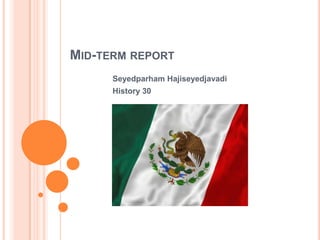
History midterm powerpoint
- 1. Mid-term report SeyedparhamHajiseyedjavadi History 30
- 2. Gods, gachupines, and gringosAgriculture Corns and beans became major crops in the Pre-Columbian history and were imported as well When the Spanish arrived, cattle and horses were major success in terms of farming Cacao, salt, jade, and cotton later became major components in the agriculture Chinampas (advanced farming technique) were made on lakes to grow vegetables.
- 3. Gods, gachupines, and gringosReligion, and its influence in Mexico During the Mexican dark ages, a very high population of people (especially the Jews and Muslims) were converted to Christianity by the Vikings and Goths. Anyone who refused to convert to Christianity were forced to leave the country and same had to face the consequences of the pope’s order. When Carlos came to power, he brought the monks and the nuns into the churches. Hidalgo (a priest) created his own army to fight against the royalists. He wanted to win the people’s freedom; however, he was defeated by the royalists and was later executed.
- 4. First stop in the new worldLuchalibre In Mexico, the wrestlers disguise their heads, so they would not be recognized. David Lida mentioned that there were usually 5 matches which lasted two and a half hours, and the seats started from four dollars to fifty dollars depending on how close they were to the ring. David Lida explained that the wrestlers were either rudoes which means tough guys, or tecnicos which means good guys (simply means technician in Spanish). The crowd also screamed so loud as if they were part of the acts, and made vulgar comments toward the wrestlers.
- 5. First stop in the new worldwinners Mexico played against Argentina in 2006 FIFA World Cup (one of my favorite matches). Even though Argentina was a much stronger team, Mexico played very well as David Lida mentioned, and was very close to win the match to advance to the quarterfinal. Argentina beat Mexico in the over time. Mexico tried its best to beat Argentina, but unfortunately they ran out of energy. It was a sad lost for Mexican people, but they played very well. chilangos made an ironic quote: “we played like never before, and lost like we always do.”
- 6. Ex Mex: from migrants to immigrantsMexican immigration Jorge Castenada, author of Ex Mex, describes how the number of migration from Mexico to the United States has increased. Castenada explains that Mexican workers move to the U.S to look for better jobs; they are usually offered low-wage jobs, and compete with many American-citizen workers. Castenada quotes: “do they prefer Mexicans to come and stay, or to come and go, or to have the best of both worlds”. One of the most controversial issues is that Americans cannot decide whether the Mexican migration should be stopped or not; this is because a very high population of people have moved to many states and have taken away many jobs, making it difficult for U.S citizens to seek employment.
- 7. Ex Mex: from migrants to immigrantspeople’s rights Castenada debated about how voting rights should be established in the U.S. for immigrants, and that negotiations should be made between the U.S government and Mexico in order for the people to live in the U.S. Castenada stated that new policies should be made; he claimed that Mexican people deserve to have social rights, health cares, as well as access to schools under different circumstances.
- 8. Engineering an Empire: the AztecsEngineering To advance food production and feed all the people, the Aztecs built chinampas on lakes which made up to seven crops of food each year. The Aztecs built aqueducts with stones five feet high and three feet wide with two different channels. One channel was very well controlled and maintained by workers, and the other one was left alone, so that the water flow does not interrupt.
- 9. Engineering an Empire: the AztecsEngineering The Aztecs constructed the Great Temples (also known as Templo Mayor) which was fifteen stories high; it had two staircases which led up to the top of twin towers to worship the gods. When the construction of Tenochtitlan began, there was no foundation to build building blocks; therefore, the Aztecs brought wooden stakes to construct the temples.
